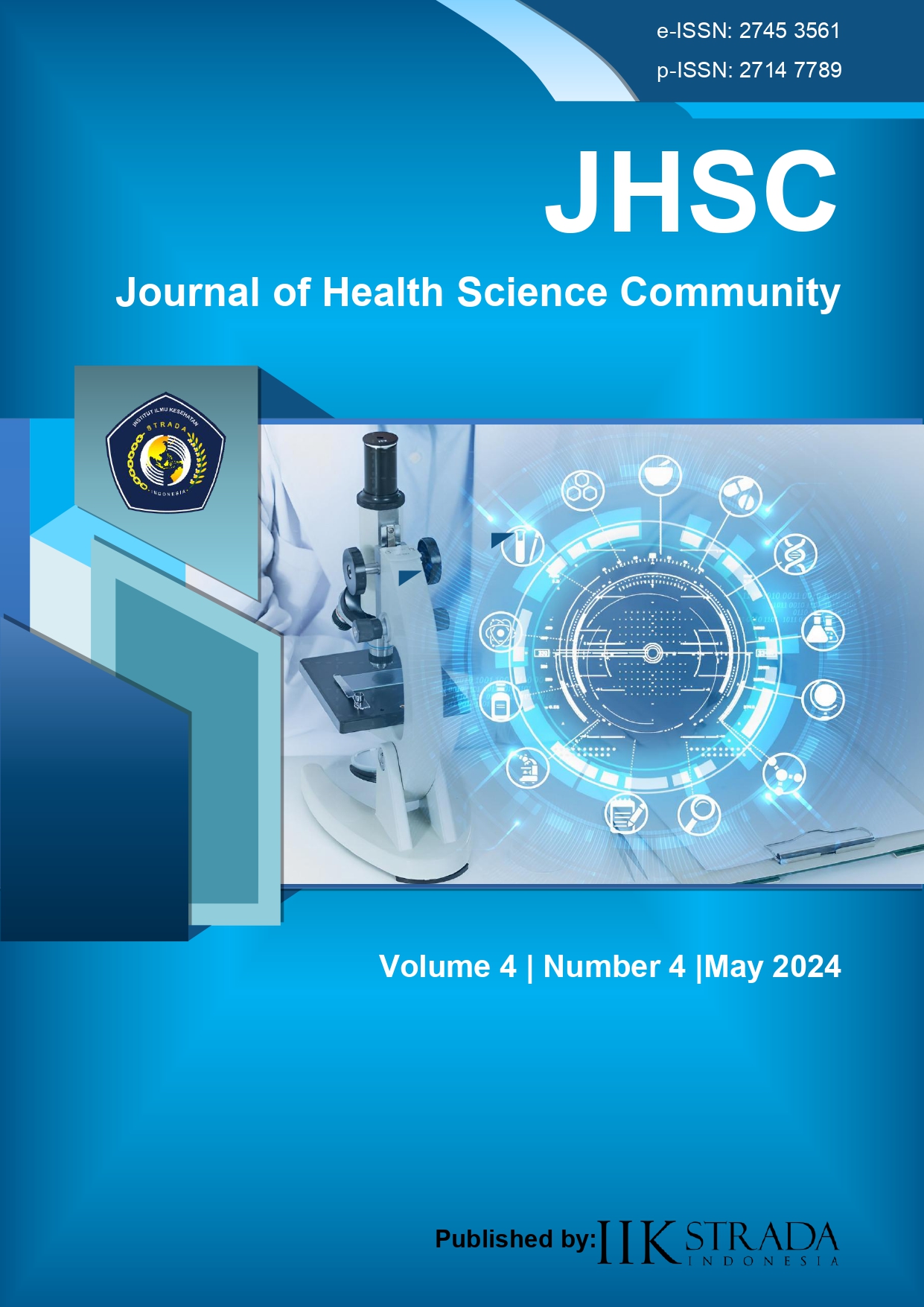Analysis of Nutritional Patterns and Preeclampsia During Pregnancy on the Incidence of low birth weight (LBW)
DOI:
https://doi.org/10.30994/jhsc.v4i4.220Keywords:
Pola Nutrisi, Preeklampsia, Berat Bayi Lahir RendahAbstract
Every year in developing countries, approximately 20 million babies are born with low birth weight and 13 million babies are born with growth disorders in the womb. The high infant mortality rate in Indonesia, namely 30 per 1000 live births, makes Indonesia rank fifth with the highest number of LBW in the world and the birth of babies with low birth weight is identified as the largest contributor to the infant mortality rate. This study aims to determine the analysis of nutritional patterns and preeclampsia during pregnancy on the incidence of LBW. This research uses this type of research analytical observational with research design cross-sectional. The population of this study was 150 post-partum mothers who had given birth at term, had pregnancy complications (CED/Preeclampsia) and gave birth in the delivery room at Merauke District Hospital from January 2021 – December 2022. Statistical test using chi square to find out the relationship between 2 variables. Research results from 150 respondents were obtained The nutritional pattern of respondents is at risk of developing CED, namely 87 respondents (58.0%), Most of the preeclampsia respondents were at risk of developing preeclampsia, namely 60 respondents (40.0%) and the majority of respondents' birth weight was LBW, namely 119 respondents (79.3%). Analysis using tests Chi-Square for KEK the results were obtained p = 0.002 (< 0.05) and preeclampsia was obtained p = 0.036 (< 0.05) so it can be concluded that there is a relationship between nutritional patterns and preeclampsia during pregnancy with the incidence of LBW in the Merauke District Hospital. Whether or not many pregnant women experience the nutritional status of pregnant women is also influenced by the performance of health service workers. For this reason, health workers, especially midwives, should continue to motivate through counseling and IEC as well as educating mothers about the incidence of LBW.
References
Ai Yeyeh, Rukiyah, Yulianti, Lia. (2010). 'Asuhan Neonatus Bayi dan Anak Balita'. Jakarta : Trans Info Medika.
Ananth, C.V., Keyes, K. M., & Wapner, R. J (2013). Pre-eclamsia rates in the United States, 1980-2010: age-periode-cohort analysis. BMJ, 347.
Atikah Proverawati. (2018). ‘Anemia dan anemia kehamilan’. Nuha Medika: Pp. 144.
Bappenas. (2018). ‘Pedoman Perencanaan Program Gerakan Nasional Percepatan Perbaikan Gizi dalam Rangka Seribu Hari Pertama Kehidupan (Gerakan 1000 HPK)’. Jakarta: Bappenas.
Cunningham FG, Leveno KJ, Bloom SL, Spong CY, Dashe JS, Hoffman BL, et al. (2014). ‘Williams Obstetrics’. 24 ed. Pp. pdf
DE A, EL A, A I. (2012) Validitas Lingkar Lengan Atas Mendeteksi Resiko Kekurangan Energi Kronis pada Wanita Indonesia. J Masy Kesehat Nas: 7(2): Pp. 83–9.
Dewi, V.L.D, Sunarsih, T. (2012). ‘Asuhan Kehamilan untuk Kebidanan’. Jakarta: Salemba Medika
Ernawati, Lilis, K., Sri, U. (2021). ‘Correlation between Gestational Weight Gain in the Second and Third Trimester and Preeclampsia Risk’ : A Study From Indonesia. Indian Journal of Forensic Medicine & Toxicology. 15(4):1072-1078.
Hariani, P. A., Khofiyah, N., & Wahyuntari, E. (2019). 'Hubungan Status Gizi Dan Pekerjaan Ibu Hamil Dengan Kejadian Bayi Berat Lahir Rendah (Bblr) Di Rsud Wates Yogyakarta' Yogyakarta: Pp.4-6
Keman, Kusnarman.(2014). 'Patomekanisme Preeklamsi Terkini'. Malang : Universitas Brawijaya Press
Kementerian Kesehatan Republik Indonesia. (2015). ‘Kemenkes 2015 profil kesehatan Indonesia 2015’. Pp.pdf
Kementerian Kesehatan Republik Indonesia. (2016). ‘Buku Saku Pemantauan Status Gizi’. Pp. 150-170.
Kementerian Kesehatan Republik Indonesia. (2020). ‘Buku Saku Pemantauan Status Gizi’.
Khairunnisa, Salma, (2018). 'Hubungan Preeklampsia terhadap Kejadian Persalinan Prematur di RSUP H. Adam Malik Tahun 2016-2017'. Repositori institusi USU, Medan: Pp. 3-7
Kristiyanasari, W.(2020). 'Gizi Ibu Hamil', Cetakan Pertama. Yogyakarta: Nuha Medika; Pp. 202-206.
Leny. (2019). ‘Faktor-Faktor Yang Berhubungan Dengan Kejadian Anemia Pada Ibu Hamil’, Jurnal Kebidanan : Jurnal Medical Science Ilmu Kesehatan Akademi Kebidanan Budi Mulia Palembang, 9(2), Pp. 161–167
Mahayana, S. A., Chundrayetti, E., dan Yulistini, (2015). Faktor Risiko yang Berpengaruh terhadap Kejadian Berat Badan Lahir Rendah di RSUP Dr. M. Djamil Padang. Jurnal Kesehatan Andalas, 4(3), Pp. 665-673.
Mallisa, B, Towidjojo, V. (2014), ‘Hubungan Antara Preeklampsia Dengan Kejadian Bayi Berat Badan Lahir Rendah (BBLR) di RSUD Undata Palu’, Medika Tadulako Jurnal Ilmiah Kedokteran, vol 1(3), Pp. 1-7
Mangiri, J., N. Mayulu dan S.E.S. Kawengian. (2016). ‘Gambaran Kandungan Zat Gizi’ Kota Manado: Jurnal Biomedik Pp.4(1):1-5
Manuaba, Ida Bagus Gde. (2018). ‘Pengantar Kuliah Obtetri’, EGC. Jakarta. Pp. 1-10
Marmi. (2012). ‘Asuhan Neonatus, bayi, balita, dan anak prasekolah’. Yogyakarta: Pustaka Pelajar.
Marmi. (2012). ‘Asuhan Neonatus, bayi, balita, dan anak prasekolah’. Yogyakarta: Pustaka Pelajar.
Maryunani, A. (2018). ‘Inisiasi Menyusu Dini ASI Eksklusif dan Manajemen Laktasi Bayi Baru Lahir’ (I; A. M@ftuhin, ed.). Jakarta: CV. Trans Info Media.
M. Sholeh kosim, dkk. (2018). ‘Buku Ajar Neonatologi’. Ikatan Dokter Anak Indonesia. Jakarta: Pp. 1-100
Maywati, Novianti. (2020). ‘Kajian katerisktik individu sebagai faktor resiko kejadian anemia pada ibu hamil’. Universitas Siliwangi : Jurnal kesehatan komunitas Indonesia.
Noorbaya, S., & Johan, H. (2019). ‘Panduan Belajar Asuhan Neonatus, Bayi, Balita dan Anak Prasekolah’, Yogyakarta: Gosyen Publishing.
Parulian, Intan. (2016). ‘Strategi dalam Penanggulangan dan Pencegahan Anemia pada Kehamilan’. Sekolah Tinggi Ilmu Kesehatan Binawan.
Prawirohardjo Sarwono (2016). ‘Buku Ilmu Kebidanan Edisi 4’. Jakarta: PT Bina Pustaka Sarwono Prawirohardjo.
Riskesdas. (2018). ‘Badan Penelitian dan Pengembangan Kesehatan Kementerian RI tahun 2018’, Pp. 104-106.
Safitri, F. Andhika. (2019). ‘Faktor Risiko Kejadian Hipertensi di Rumah Sakit Umum Daerah dr. Zainoel Abidin Provinsi Aceh’. Journal of Healthcare Technology and Medicine, 5(1), Pp. 148
Sembiring, Julina Br. (2019). 'Asuhan Neonatus, Bayi, Balita, Anak Prasekolah'. Yogyakarta: Deepublish
Sukri, Ahmad. (2016). 'Mengenal Mendampingi dan Merawat Anemia'. Jakarta : Bee Media Pp. 2-4.
Susilowati dan Kuspriyanto. (2016). ‘Gizi dalam Daur Kehidupan. Bandung’. : Refika Aditama
Syafitri, E. & Mardha, M. S., (2020). ‘Factors Affecting Anemia in Pregnant Women. Jurnal Proteksi Kesehatan’, Volume 9, Pp. 16-24
Uki Nengsih., Noviyanti., & Dedi Djamhuri. (2016). ‘Hubungan Riwayat Kelahiran Berat Bayi Lahir Rendah Dengan Pertumbuhan Anak Usia Balita’. Midwife Journal, Pp. 2(1)
Waryana, dkk. (2016). Kebiasaan Makan Menjadi Salah Satu Penyebab Kekurangan Energi Kronis (KEK) Pada Ibu Hamil Di Poli Kebidanan Rsi&A Lestari Cirendeu Tangerang Selatan. Tangerang : Universitas Islam Negeri Syarif Hidayatullah.


















